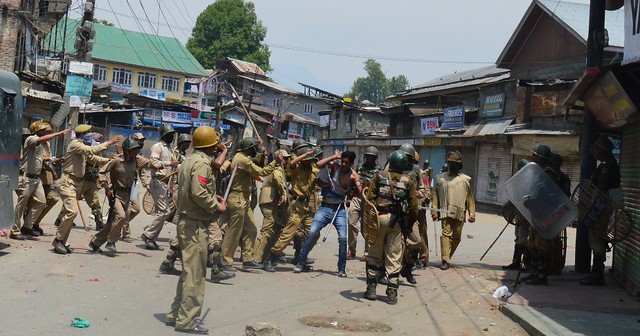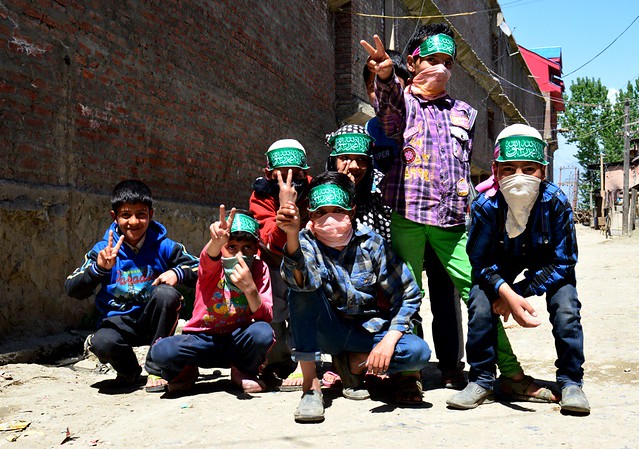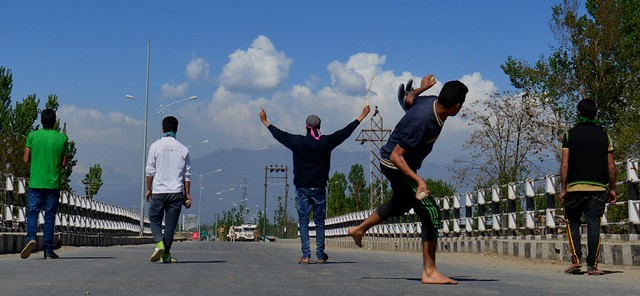By Raqib Hameed Naik, TwoCircles.net
Srinagar: Four dozen dead. Thousands injured. Hundreds, mostly teenagers, blinded forever. Mobile internet shut; local cable channels off air, local media gagged.
The year may be different; but it would be safe to say that in the bloodied history of Kashmir, this is just one more chapter where the entire concept and structure of democracy has been put to rest.
In some ways, one may say that the current situation in Kashmir is reminiscent of the 2008 and 2010 unrest, and security forces in Kashmir have once again put an enigma on the concept of democratic India, as stones and anger continue to be retaliated with bullets.
If we go by the death figures alone, it would seem however, that the current situation seems to be more serious than the previous unrests, where a dozen Kashmiri protesters used to get killed in security forces action over a month’s stretch (in 2010, 120 protesters lost lives over five months of unrest) but the death of over 40 protesters in a span of six days represent something very rotten inside the system.

2 A youth being thranshed mercilessly by Indian Security forces in Maisuma area of Srinagar
The other difference between 2010 and now is of course, that now the state is ruled by the Peoples Democratic Party in coalition with the BJP. In 2010, Mehbooba Mufti spit fire against Omar Abdullah over the deaths and during the run-up to the last elections, the PDP promised a ‘healing touch’ to Kashmiris. All such promises have now come down crashing in the second year of its rule.
The latest killings in Kashmir after security forces neutralized Hizbul Commander Burhan Muzaffar Wani has once again turned the debate around who should be blamed for repeated unrests. The high-handedness of the security forces? The incompetent government? The failure of the central government to understand the Kashmir issue?
The debate around the Kashmir killings might take different directions when discussed in any Indian state. But in Kashmir and Chenab valley, it revolves around the three factors: the successive state government’s inability to learn from the past experiences, the brute use of force on its own people, whom they are supposed to protect and alienation of Kashmiri people by the mainstream Indian media.
Governments yet to learn from experiences of their predecessors
People in Kashmir are of the opinion that the governments, both central and state, have never learnt from the mistakes done by their predecessors. After the unrest of 2008 and 2010, when hundreds of youths fell to security forces bullets, then UPA-led central government and NC-Congress-led state government assured Kashmiri populace of damage control by ostracizing security force personnel’s involved in the killings and promised measures to resolve the Kashmir issue, which at the time of demitting their respective offices remained largely unaddressed. The governments also decided to appoint a three-member interlocutor and the team visited every part of state and recommended some affirmative measures to be taken to address the growing alienation of Kashmiri people. But what was to follow was not surprising: both the previous and the current NDA government are sitting on the recommendations, which further shook the belief of Kashmiris in the Indian Government.

“Appointment of interlocutors was one of the major steps taken by the then UPA government. But six years after its appointment and subsequent filing of report by the three-member team, the recommendations remains largely ignored. I still remember how optimistic people were then about the outcome of possible solution to the problem, but it was only to buy time and let the anger of people die down,” Samiullah Khan, a university student from Srinagar, told TwoCircles.net.
When youths were being shot dead in the previous unrests, then opposition leader, now the Chief Minister of the state, Mehbooba Mufti was the vocal face against the state repression and a number of Kashmiris believed in her promises and voted her to power. The present situation however shows how in Kashmir, regional parties indulge in blood politics by deceiving people of the very promises made when out of power. “Being a woman, she understands the pain of mother who has lost her son better. If she can’t, then she has no right to be on the top chair,” Khan adds.
The brute history of the use of excessive force
Ask a common Kashmiri: what is the definition of security forces? The answer is prompt: ruthlessness.
After every killing in Kashmir, the government promises action and forces promise restraint. But now the Kashmiris know that these are to remain mere promises which never see the light of the day.
“Is stone such a lethal weapon that needs to be retaliated with bullet? Is it necessary to shoot pellet guns at protesters from close range making them blind? Don’t Kashmiri lives matter?” asks Khalid-E-Sani Sheikh from Doda district.
The security forces, especially the J&K Police and CRPF’s way of dealing with protesters also puts a question mark over the way they are trained to contain the violent situations.

“Mehbooba Mufti is the head of unified command and holds the charge of Home Ministry. Yet, in her capacity she has done little to improve the situation in the valley. Pointing and blaming every protest or unrest to ‘vested interests’ isn’t the answer to the problem and she can’t hide her shortcomings under the grab of her imaginative reasons for unrest,” says Sajid Khan from Baramulla District of Kashmir.
During elections, the political parties appeased the Kashmiris with phrase, “Ballot is the answer to bullet”. After assuming charge, the same parties change their stance and have implemented the phrase “Bullet is the answer to the stones” on the very same people who elected them to power.
The Jammu and Kashmir police are very unpopular with people in Kashmir and have been time and again accused of resorting to brute and harsh methods of dealing with public.
“While pointing their guns towards people, don’t they think twice that they are killing their very own people from the very same society to which they belong? Has power corrupted their vision to such a large extent?” asks Mubashir Zargar from Doda.
Indian media and the alienation of Kashmiris
When it comes to Kashmir, the role played by mainstream India media has always been under the scanner.
Go to Kashmir and identify yourself as a reporter from any mainstream Indian news channel. You are mostly likely to be in for a short lecture on how painful it is for them to tune on to a mainstream news channel.
As security forces were aiming ‘shoot to kill’ in Kashmir for the last one week, mainstream media was busy vilifying Burhan Muzaffar Wani and talking of his love life, the betrayal of an ex-girlfriend, while completely bypassing the important question of human rights violations in Kashmir.
The stories of how security forces were going berserk, ruthlessly attacking ambulances and even hospitals along with injuring the already injured was not reported on even a single mainstream news channel.
“See, the mainstream media has always adopted a biased approach towards covering the conflict in Kashmir. By referring to protesters as mobs, rebels as terrorists and never reporting the security forces excesses, they are not resolving any problem. Instead, they are only adding to the alienation of Kashmiris ,” said Haq Nawaz Nehru, a veteran journalist from Jammu.
The politics over the killings is already in full red bloom, as the pain of the oppressed has now, ironically, been taken over by the National Conference, which is now in opposition. The party issued statements on killings and condemned the actions, conveniently forgetting that hundreds of Kashmiri youths were killed by security forces when it was ruling the state between 2009 and 2014.
Under the ‘young’ leadership of Omar Abdullah, the Valley saw one of its most-troubled periods, with 120 people, mostly youths shot by security forces, dead in five months of protests in 2010.
Is Kashmir heading towards another year of turmoil? How many more people will fall to the bullets before guns goes silent?
These questions can’t be answered right now, but the course can be changed if both the central and state government came out of their rhetorical web and adopted a serious realistic approach aimed at resolving the issues of human rights violation at the hands of forces once for all. But until then, July 2016 will remain just another chapter stained by blood in Kashmir’s turbulent history.

